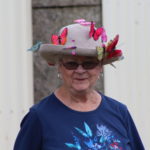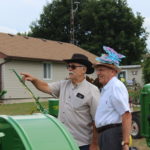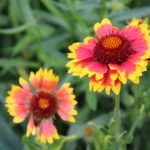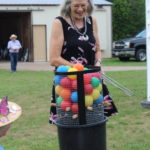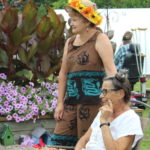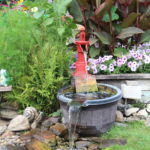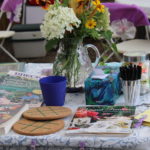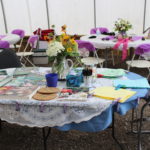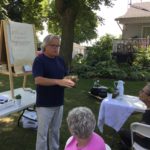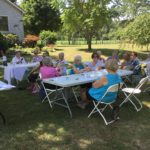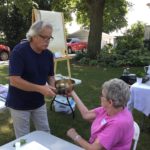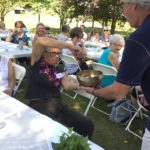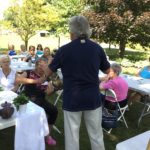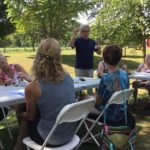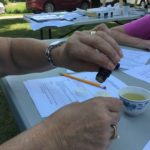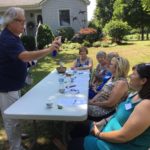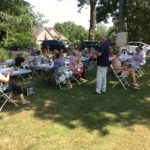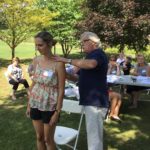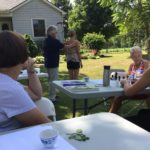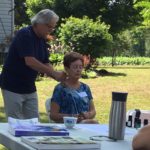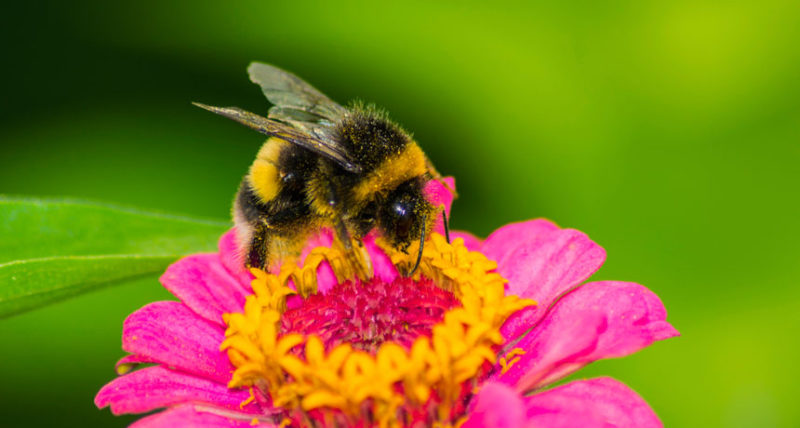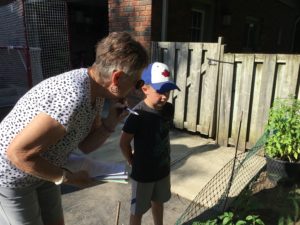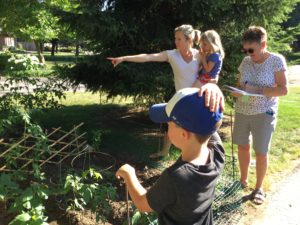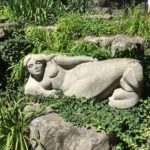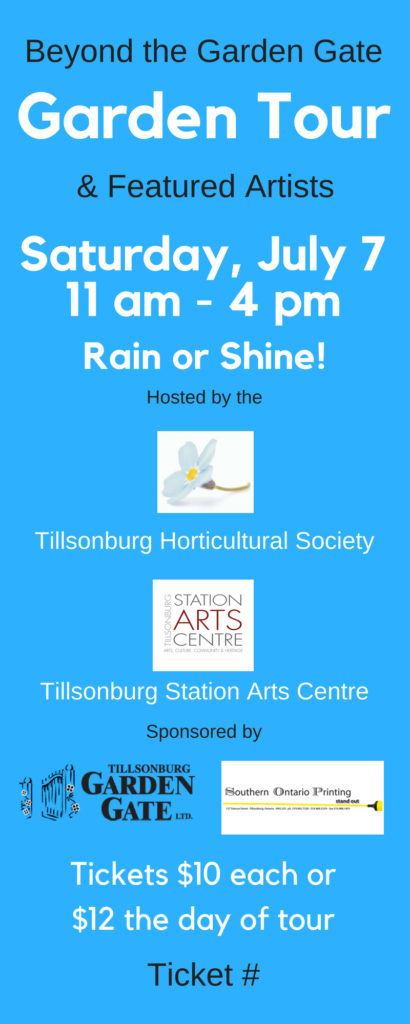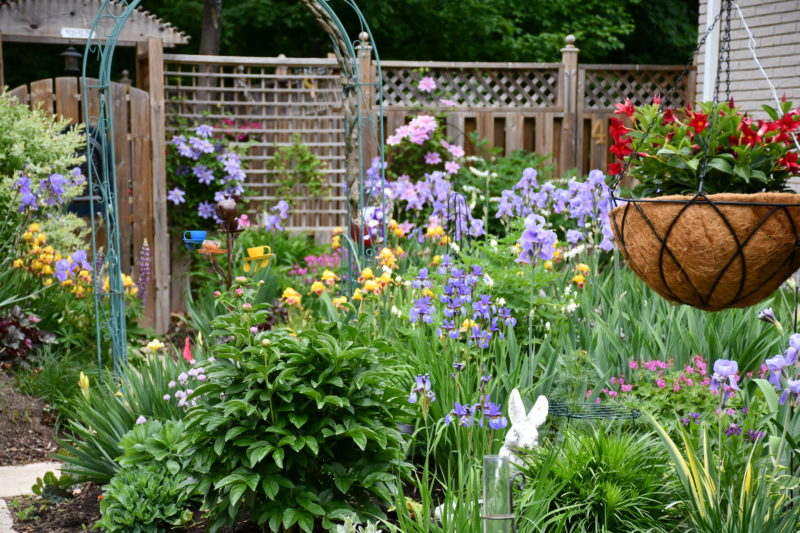- Photographs courtesy of Tamara Pettman, photographer.
Author Archives: Penny Esseltine
Aromatherapy and Nature Mix
Registered Aromatherpist Mitchell Hewson presented an Aromatherapy workshop for an enthusiastic group of Horticultural Society members and friends on Saturday, August 11. Organized by Judi Misener, the workshop was held at Christine Nagy’s farm.
We Need the Bees
It’s Still Just Dirt, The Tillsonburg News – July 2018
by Angela Lassam
Without bees there would be no fresh food. The bees are one of the most important pollinators. Agriculture increasingly realises the natural value of bees and contract with beekeepers to pollinate crops. You may notice bee hives placed strategically on field sidelines especially melon fields locally. When vegetables and fruit are grown in our gardens we naturally get the pollination done for us. The wild habitat they need is disappearing fast as population needs rise so there is an urgency to allow wild spaces to be replanted with relevant vegetation. Gardeners can help too by growing flowers, vegetables and fruit with good and easy access. A corner of the garden could be planted with wild flowers where they can forage naturally.
There are over 40,000 species of bees worldwide and 1,000 of those are found in Canada. Bees have a round body covered in feathery hairs which transport the pollen as they feed and collect for the nest. They have two pairs of clear wings, large compound eyes and a proboscis to collect the pollen. They have a four stage life cycle – egg, larva, pupa and adult. Not all bees survive over the winter. Honey bees gather inside the hive in what is described as a cluster to survive.
Bees do not naturally sting unless stepped on or attacked when foraging for food. The honey bee can only sting once and then will die. They are not normally aggressive and should not be confused with a wasp. Wasps will sting repeatedly and in swarms. They can be distinguished by their very different appearance to the bee. A wasp has a narrow, thin, shiny body with bright coloring and longer thin legs. In spring they will eat insects but come summertime they invade any rotten garbage to eat the sugars collecting there.
In the garden we can help the bees by growing many plants in all seasons. In spring there is crocus, hyacinth and daffodils. For summer any fruit, cosmos, snapdragons, borage, beans and peas to name a few. For fall grow zinnias, asters, goldenrod and echinacea. There are many more worth mentioning but all have flower heads that are single and easy to reach in to get the pollen.
Now some fun facts about bees. They are the only insect that can make food that we can eat. They recognize the human face. They fly at 24 km/hr. They love caffeine.
The past garden tour in conjunction with the Station Arts Centre at the beginning of the month was very well supported and many thanks to all those who purchased tickets. Many hours went into the preparation of the gardens by the garden owners and the volunteer support so thanks there too. Plans are already in progress for another wonderful day next year.
In August there will be a workshop with Mitchell Hewson. The workshop is Saturday, August 11 from 1 to 4 p.m. Two different creams will be made by each participant. Mitchell Hewson, world renowned Horticultural Therapist will lead the hands-on workshop as well as teach about the healing properties of essential oils. Mitchell was extremely well received by the members when he was the society’s guest speaker last October. Contact Judi Misener at judimisener@gmail.com. Non- members are welcome. Open to everyone!
Lastly monthly meetings resume on Tuesday, September 4 @ 7.30 p.m. in the Senior Centre Auditorium, Tillsonburg Community Centre. Topic is Fall Decorating with Hilde Makkink of Sunflower Farm, Tillsonburg.
Everyone welcome. For more information look on Facebook Tillsonburghorticultural or check the website www.tillsonburghorticultural.ca
2018 Junior Gardeners Gallery
Junior Gardeners show their Gardens
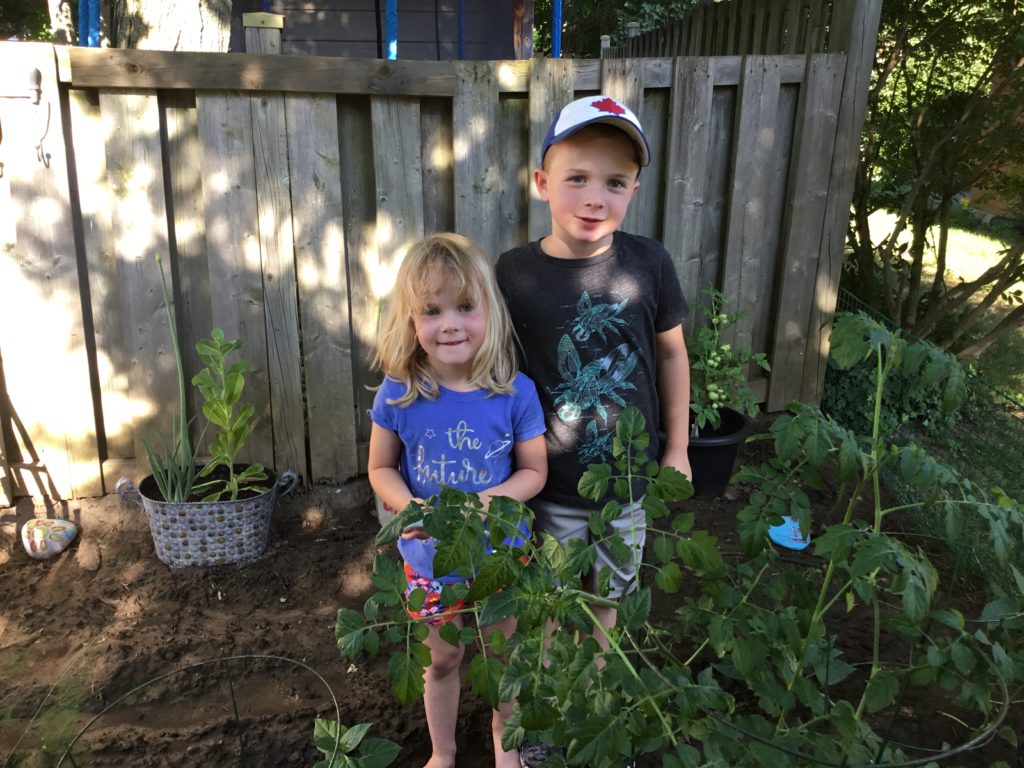
Kyla (age 4) and Ryan (age 6) Preiss are participants in the Tillsonburg Horticultural Society Junior Gardeners program this year.
Between July 16 and July 27 volunteer members of the Tillsonburg Horticultural Society are visiting about 148 gardens planted and nurtured by local Junior Gardeners to see and talk about their gardening experiences. Chris Suttie heads up the Junior Gardener Program for the society and she says it’s a lot of fun for the adult members of our group too and the gardens can be absolutely amazing.
Once children sign up for the Junior Gardener Program they are provided with a package of plants and seeds to grow in their garden. This year’s theme has been Salsa and Salad and the plants have included beans, beats, cilantro, corn, marigolds, four o’clocks, onion bulbs, a jalapeño plant and a tomato plant.
Children can design their gardens any way that they want. They can grow their gardens directly in the ground, in containers, or a combination of both. “They are encouraged to add other things of their own choosing as well,” Chris says. In some gardens this has included sunflowers and especially kale.
Chris says 285 children from Tillsonburg and Courtland Schools as well as some independents are taking part in the program this year. She says the gardening program for children provides a great opportunity for parents, or grandparents, or older siblings to support the kids in their gardening efforts.
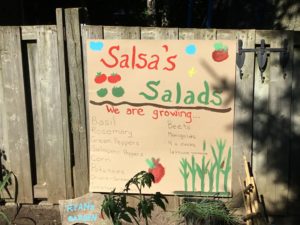 A season-ending Awards Night for this year’s Salsa and Salad Junior Gardener Program will be held on September 25.
A season-ending Awards Night for this year’s Salsa and Salad Junior Gardener Program will be held on September 25.
2018 Tour of Gardens Retrospective
Get Your Ticket for July 7 Garden Tour
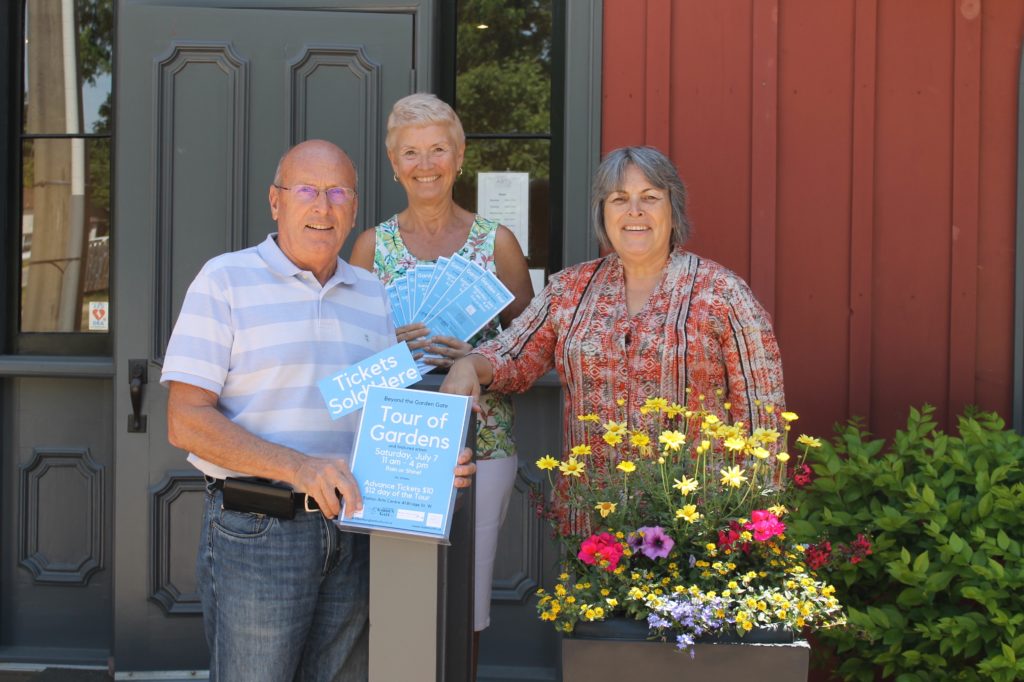
Tillsonburg Horticultural Society’s Reg and Janet Butcher, and the Station Arts Centre’s Deb Beard have Beyond the Garden Gate Garden Tour tickets all ready to go..
Plans for the 2018 Beyond the Garden Gate Garden Tour are all in place and the July 7 event will feature a total of six spectacular gardens in Tillsonburg and area. The event is coordinated by the Tillsonburg Horticultural Society along with Tillsonburg’s Station Arts Centre. Each garden will feature the work of a local artisan or musician.
Tickets for the Tour of Gardens cost $10 in advance or $12 on the day of the tour. They are available at the Station Arts Centre on Bridge Street, and at Merle Norman and Tillsonburg Garden Gate on Simcoe Street, as well as from organizing members of the Tillsonburg Horticultural Society.
We will be hoping for a beautiful day but of course the tour will go ahead rain or shine. Tillsonburg Garden Gate will offer a discount to shoppers (with a Tour of Gardens ticket) at their garden centre Friday through Sunday on the weekend of the tour. The Station Arts Centre will be open as well offering refreshments and an opportunity to enjoy their current exhibit called Horizons as well as the Bridge Street Gallery featuring work of the Stationhouse Potters.
A special thanks to all of the gardeners who are tirelessly preparing to share their gardens. Garden Visit Etiquette tips are printed on the back of the Garden Tour ticket/brochure.
War on Japanese Beetles
It’s Still Just Dirt, The Tillsonburg News – June 2018
by Angela Lassam
June is the start of the Japanese beetle invasion on our gardens. No garden will avoid this destruction. It happens as soon as all the hard work is done to get our gardens doing well.
The Japanese beetle originally was confined to Japan. It was only found there as it was surrounded by water and had natural enemies like the parasitic wasp. The beetles arrived in North America as grubs in the soil on iris roots and were first found in a nursery in New Jersey in 1916. A law was introduced in 1912 for no plants allowed in soil to enter the country but it was not implemented at that time. By 1920 an eradication program was dropped as there were just too many beetles to control. In USA it is a huge problem and it is reported that after spraying they can be shoveled up in bucketfuls.
The beetle is very noticeable approx. ½” in size and quite colorful. It is a mix of copper and metallic blue/green and very rarely only one but several appear together. Their cycle runs over two years. They lay eggs in the soil beginning early June where they turn into tiny white grubs approximately ¼” and stay there eating the roots of grass or other plants growing up to 1”. They go deeper over the winter resurfacing late spring as beetles to start the cycle again. Their adult stage is only 40 days long but during that time they are very prolific and destructive.
There are several ways to reduce the infestation at different times of their life cycle. The grass can be treated with nematodes which will kill the larvae in the soil. An alternative treatment of milky spore can be used. It is a longer term treatment but it is more expensive as larger areas need to be treated.
A homemade solution of 2 tbsp of dish soap and 1 gallon of water will treat 1000 sq. ft. sprayed on obvious affected areas in early morning. It will bring the grubs up and will be natural food for the birds.
As adults they can be handpicked into a bucket of soapy water. There are traps for them available in nurseries. They need to be placed away from any vegetation (edge of property). There is controversy about these as they actually can draw them from the neighborhood.
There are companion plants that deter them especially marigolds and geraniums. Geraniums make them dizzy when near them and they will drop to the soil where they can be easily picked up into a bucket of soapy water.
There are some plants they will not eat in the vegetable patch. Squash, onions, lettuce, parsley, spinach and potatoes are just a few. Some trees are also disliked – Red bud, Dogwood, Red Maple. Shrubs affected could be Rose of Sharon and Burning Bush. They do like most fruit trees, beans and especially Canna lilies.
Good luck with you war on these pests and I hope it helps some of the many gardeners plagued by these “pretty” beetles.
The Horticultural Society has three Summer events planned over the period that there will be no meetings. The first one is the “Beyond the Garden Gate” garden tour taking place on Saturday July 7th, 11am – 4 pm, rain or shine. Tickets are $10 in advance obtainable at Station Arts Centre, Merle Norman or Tillsonburg Garden Gate. Also contact any board member for one or more, $12 on the day at any of the gardens. This event is open to everyone.
The tour comprises of six gardens, all easy travelling distance around Tillsonburg with stops at Tillsonburg Garden Gate and Station Arts Centre. Each location will have a local artisan either artistic or musical. Tillsonburg Garden Gate is giving ticket holders a discount on any purchase for the weekend. Station Arts Centre as usual is admission free. Purchase of a ticket gives you a detailed map and description of all that is available on the tour so come out and see what some of our members achieve with their gardens and enjoy a pleasant drive.
The second event is a social Garden Party/Potluck Supper on Thursday, 26th July with an afternoon of games, quizs, contests, antique display and music. This event runs from 4 – 8 pm with potluck supper @ 5:30 pm. Watch Facebook for more details, check in the Tillogram or email host Angela Lassam farmer@kwic.com phone 519 936 8117. All members welcome (with spouse/partner/friend too) just bring a potluck dish to share, come and have some fun.
The third event has been prepared as members have requested a workshop. The workshop is Saturday, August 11th from 1 to 4. Two different creams will be made by each participant. Mitchell Hewson, world renowned Horticultural Therapist will lead the hands-on workshop as well as teach about the healing properties of essential oils. Mitchell was extremely well received by the members when he was the Society’s guest speaker last October. Contact Judi Misener at judimisener@gmail.com. Non members are welcome, open to everyone!
Normal monthly meetings will resume on Tuesday, September 4th @ 7:30 pm in the Senior Centre Auditorium Tillsonburg Community Centre. For more information look on Facebook Tillsonburghorticultural or the website www.tillsonburghorticultural.ca .
Native Plant Nursery – June 5
St. Williams Nursery & Ecology Centre operates over 400 acres of field production and 10 acres of greenhouse space in Southern Ontario and this makes it the largest source-identified native plant nursery in the province. The guest speaker for our June General Meeting, Stefan Weber, comes from this centre and his presentation on Tuesday, June 5 will focus on native plants and trees. St. Williams is unique in the nursery trade – it is the only major supplier that specializes exclusively in native seed and plants for biodiversity conservation of Ontario native wild-type plant genetics.
The meeting will start at 7:30 p.m. in the Senior Centre Auditorium at the Tillsonburg Community Centre. An annual membership in the society costs $15.00. Everyone welcome. Refreshments follow.
Although there are Horticultural Society activities taking place during the summer months (including the July 7 Beyond the Garden Gate Garden Tour) regular meeting are suspended during July and August and the next general meeting will be held on September 4.
Evergreens are Not Just Conifers
It’s Still Just Dirt, The Tillsonburg News – May 2018
by Angela Lassam
Evergreens are a major part of any landscape or garden design because the colour does not vary with the seasons although some may become dull throughout the winter months. They are generally the basis and add structure to any space.
We all know that spruce and pine and other conifers are evergreen but we may not think of the many shrubs and plants that are also in the evergreen family. To identify an evergreen look to its botanical name where you should find sempervirens which in Latin is always (semper) and green (virens).
Holly, mountain laurel and euonymus come in the evergreen bush/shrub class and most gardeners have at least one of these in their gardens.
Rhododendron is also evergreen with its shiny leaves and can grow very large. In late spring they will produce an abundance of flowers in a huge variety of colors.
Boxwood is a great bush to give definition to pathways and intricate designs. It is used in topiary as it is a slow grower and easy to prune into intricate shapes. Boxwood was used extensively in Victorian gardens to edge walkways and make interesting scenery.
Periwinkle, ivy and many groundcovers are also evergreens although maybe we do not consider them to be. There are succulents that come in the evergreen family that we are all familiar with being hens and chicks and yucca. Heather is an evergreen and it is common to find these in rock gardens. It can also be used as a groundcover.
The Town-wide Commercial Urn Beautification Project has had a slow start this year no doubt due to the cold weather and so many businesses purchasing them for the Canada 150th last year. This year the society hopes to continue this program. Orders for an insert package or a complete urn has been extended so please contact Kathy McCormick 5194034035 or email k.mccor7013@gmail.com for more info.
The arrangement this year will be very colourful with bright pink dipladenia, yellow mini canna lilies and white million bells. They will match the large urns on Broadway and will be delivered to your door. This is available to all businesses. You not need to be on Broadway to participate so please consider purchasing one or more.
Lastly the Garden Auction in its 12th year was a huge success once again. Many volunteers spent the earlier part of the day in preparation and thanks to all of you for that. Thanks go out to all who attended and participated to make it such a huge boost to our funds. This allows the Society to keep our town looking great in so many ways.
The next monthly meeting will be on Tuesday, June 5th @ 7.30pm in the Seniors Auditorium, Tillsonburg Community Centre. The speaker will be Stefan Weber from St. Williams Nursery and Ecology Centre in St. Williams which is a great source for all native plants and trees in Ontario. Everyone welcome. For members there will be signups for the summer social and a workshop so check your Tillogram for details.
More info can be found on www.tillsonburghorticultural.ca. Also follow us on facebook Tillsonburghorticultural.
